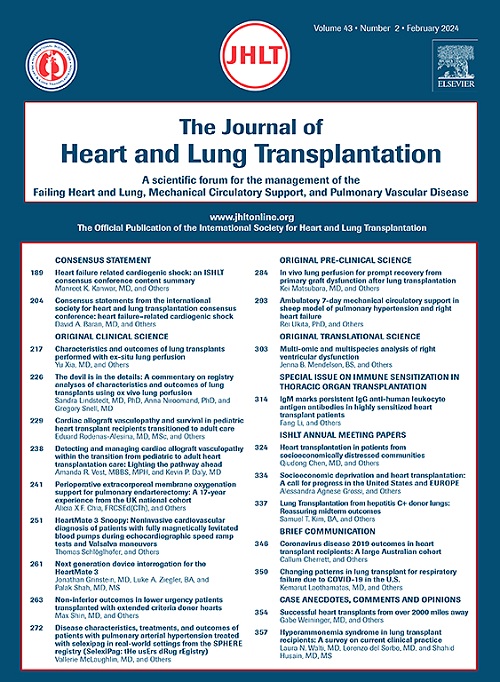蛋白质组学和代谢组学分析提名肺动脉高压相关肌病和运动不耐受雄性大鼠的药物靶点和生物标志物。
IF 6
1区 医学
Q1 CARDIAC & CARDIOVASCULAR SYSTEMS
引用次数: 0
摘要
背景:肺动脉高压(PAH)是一种罕见但使人衰弱的疾病,可导致运动不耐受并最终死亡。骨骼肌紊乱导致PAH患者运动能力下降,但肌肉功能障碍的机制,包括基于纤维类型的肌肉生物学变化,尚未得到充分研究。方法:我们在单胆碱(MCT)大鼠PAH模型中评估了股四头肌(主要是快纤维)和比目鱼肌(主要是慢纤维)的运动能力、肌肉组织病理学、线粒体密度、线粒体蛋白质组学和代谢组学/脂质组学。结果:MCT大鼠表现出运动能力受损。令人惊讶的是,MCT大鼠的股四头肌和比目鱼肌存在不同程度的萎缩和代谢重塑。在股四头肌中,只有II型纤维有轻微的萎缩反应。相比之下,I型和II型纤维在比目鱼肌萎缩。两组肌肉均表现出纤维化浸润,但线粒体密度仅在股四头肌降低。线粒体蛋白质组学和组织代谢组学/脂质组学分析表明,当股四头肌氧化磷酸化/脂肪代谢和甘油三酯储存受损时,这两种肌肉表现出不同的反应。然而,比目鱼表现出蛋白酶体缺乏和磷脂酰胆碱/磷脂酰乙醇胺稳态改变的迹象。最后,对血清中代谢物/脂质进行分析,确定了PAH中运动不耐受的潜在新生物标志物,包括二甲基精氨酸途径、半胱氨酸和甘油三酯。结论:我们的数据表明,多环芳烃引起的肌病发生不同的恶病质和代谢反应。我们提名线粒体生物发生和蛋白酶体激活作为pah肌病的潜在药物靶点。本文章由计算机程序翻译,如有差异,请以英文原文为准。
Proteomic and metabolomic profiling nominates druggable targets and biomarkers for pulmonary arterial hypertension–associated myopathy and exercise intolerance in male monocrotaline rats
Background
Pulmonary arterial hypertension (PAH) is a rare but debilitating condition that causes exercise intolerance and ultimately death. Skeletal muscle derangements contribute to depressed exercise capacity in PAH, but the mechanisms underlying muscle dysfunction, including the changes in muscle biology based on fiber type, are understudied.
Methods
We evaluated exercise capacity, muscle histopathology, mitochondrial density, mitochondrial proteomics, and metabolomics/lipidomics of quadriceps (predominately fast fibers) and soleus (predominately slow fibers) muscles in the monocrotaline (MCT) rat model of PAH.
Results
MCT rats exhibited impaired exercise capacity. Surprisingly, there were divergent atrophic and metabolic remodeling in the quadriceps and soleus muscles of MCT rats. In the quadriceps, there was a mild atrophic response only in type II fibers. In contrast, both type I and II fibers atrophied in the soleus. Both muscles exhibited fibrotic infiltration, but mitochondrial density was reduced in the quadriceps only. Mitochondrial proteomics and tissue metabolomics/lipidomics profiling demonstrated that the 2 muscles exhibited distinct responses, as the quadriceps had impairments in oxidative phosphorylation/fat metabolism and storage of triacylglycerides. However, the soleus showed signs of proteasome deficiencies and alterations in phosphatidylcholine/phosphatidylethanolamine homeostasis. Finally, profiling of metabolites/lipids in the serum identified potential novel biomarkers of exercise intolerance in PAH, including the dimethylarginine pathway, cysteine, and triacylglycerides.
Conclusions
Our data suggest differential cachectic and metabolic responses occur in PAH-induced myopathy. We nominate mitochondrial biogenesis and proteasome activation as potential druggable targets for PAH myopathy.
求助全文
通过发布文献求助,成功后即可免费获取论文全文。
去求助
来源期刊
CiteScore
10.10
自引率
6.70%
发文量
1667
审稿时长
69 days
期刊介绍:
The Journal of Heart and Lung Transplantation, the official publication of the International Society for Heart and Lung Transplantation, brings readers essential scholarly and timely information in the field of cardio-pulmonary transplantation, mechanical and biological support of the failing heart, advanced lung disease (including pulmonary vascular disease) and cell replacement therapy. Importantly, the journal also serves as a medium of communication of pre-clinical sciences in all these rapidly expanding areas.

 求助内容:
求助内容: 应助结果提醒方式:
应助结果提醒方式:


